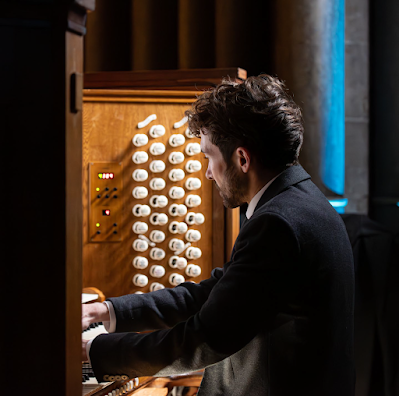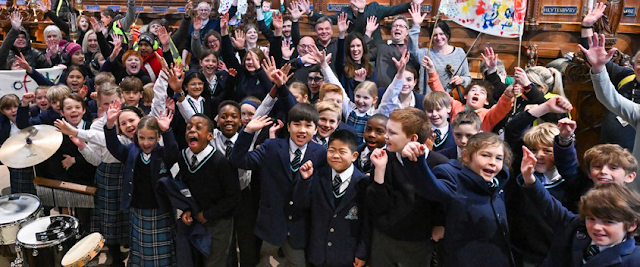The organ in Salisbury Cathedral was originally built in 1876-77 by Henry Willis (“Father” Willis), conservatively rebuilt by Henry Willis III in 1934 so that no tonal alterations were made and no pipes removed, the organ has been sensitively looked after since then and as a result, aside from small changes of layout, mechanics and specification, the organ remains as Willis left it in 1877. The tonal scheme has remained unaltered, with the majority of the pipework and soundboards dating from 1876. The instrument retains its historic pitch, and the majority of pipework remains cone-tuned, unique for a cathedral organ in England.
 |
| John Challenger at Salisbury Cathedral (Photo: Ben Tomlin) |
As such, the organ gives us a glimpse of the sound world of the later 19th century English organ tradition which was moving the instrument toward symphonic dimensions. Transcriptions were popular; producing organ versions of the symphonic repertoire is something whose popularity has waxed and waned. On a new recording from Salisbury Cathedral, assistant director of music John Challenger demonstrates that the transcription is alive an well, with a version of Holst’s The Planets created for and played on the Father Willis organ.
What makes the project just that little bit special is that the performance is accompanied by a superb film, by Ben Tomlin, which mixes footage of Challenger playing with hypnotic images of the cathedral at night. The film is available online, a terrifically generous gesture. If you do watch the film on YouTube, be sure to visit the cathedral’s donation page too.
Challenger’s transcription works because he does not try to make the 19th century Willis organ sound like Holst’s large orchestra. Who could. Instead he reinvents Holst’s brilliant orchestrations in organ terms and the result has its share of bravura moments as hands and feet rattle around the consoles and pedalboard, but has plenty of sonic magic. The transcription inevitably lacks some of the fleet dazzle, the ability to turn on the head of a pin, that characterises Holst’s orchestra but instead there is a brooding majesty, and a philosophical profoundness to the music, with Challenger and the organ bringing out the essential melancholy and vein of darkness that there is in much of Holst’s music.
It helps that this is accompanied by images of the cathedral which are anything but simple picturesque views, and which help deepen our perceptions.
Amazingly, this film and recording is the result of a two-year project which began as an initiative to share Holst’s music with school children who might not otherwise know The Planets, and such was its popularity that it became a two-year project. The initial project was a collaboration with four Salisbury schools including Exeter House School – Salisbury’s school for children with severe, profound and multiple learning difficulties – supported by the music charity La Folia.
Workshops with composer Howard Moody, led the pupils to create responses to Holst’s work: words, music and dance, all performed alongside movements from The Planets arranged specially for the Cathedral organ. The Education Department led pupils in creative sessions with the poet Martin Figura, and the full suite was also heard in a concert setting, a corresponding new poem by Figura preceding each movement.
 |
| Children at one of The Planets workshops at Salisbury Cathedral (Photo: Finbarr Webster) |
The cathedral’s education manager, Katherine Dolphin, explains how the music and the cathedral itself were drawn together in the workshop sessions:
‘The Cathedral’s Education volunteers led tours around the building, creating links between the musical characteristics of The Planets and different features of our Cathedral. For example, Saturn, the Bringer of Old Age, was linked both to our ticking medieval clock and to the great age of the building; Mars, the Bringer of War, provided an opportunity to look at the Cathedral’s military flags; the William Pye font, with its still surface and calm, flowing water, presented an opportunity to reflect on Venus, the Bringer of Peace.’
‘The pupils sat beneath the Father Willis organ, listening to John play excerpts from The Planets before discussions about the music. Following the workshops, Martin has taken elements of the pupils’ own writing to create a special planets- themed poem for each school to keep as a unique memory.’
What lifts this out of an admirable education project into something else entirely, is John Challenger’s imaginative response to Holst’s music and his creative sense when reinventing The Planets for 19th century organ. A vision that might seem quixotic and a little mad but which Challenger brings off with superb confidence, elan and imagination. And of course the images (include drone footage) of the cathedral to match the mood.
For Neptune, Challenger is joined by the choristers of Salisbury Cathedral Choir, conductor David Halls. The audio was recorded over three days, 25 May and 15, 16 October 2023, whilst filming was done on two of those days plus 27, 28 February 2024. The film was directed by Ben Tomlin, with drone footage by Simon Brown, and taking advantage of Ricardo da Fonseca’s superb lighting of the cathedral.
I have embedded the YouTube video above, but please do visit the cathedral website for further information about the project [https://bit.ly/3zjadCg], If you do watch the film on YouTube, be sure to visit the cathedral’s donation page too.
The blog is free, but I’d be delighted if you were to show your appreciation by buying me a coffee.
Elsewhere on this blog
- Melodies without Borders: two Turkish musicians mixing lyric melancholy with 19th century bravura – concert review
- Letter from Florida: Sarasota Opera Concert Performance, The Music of Giuseppe Verdi – concert review
- The music is there, we only have to open our eyes: pianist Alexandra Dariescu on 100 Nutcrackers, advocating for women composers & a new direction at the Leeds International Piano Competition – interview
- If you go down to the woods: a gender-fluid witch & an oppressive religious sect, Hänsel und Gretel from Royal Academy Opera – opera review
- Au cimetièrère de Montmartre: Julien Van Mellaerts & Alphonse Cemin in an imaginative trawl thro’ the denizens of a Paris cemetery – concert review
- Letter from Florida: New World Symphony Veterans’ Day Concert, A World War II Journey with Lidiya Yankovskaya & Emily Magee – concert review
- Glorious performances from Rhian Lois and Thomas Atkins lift ENO’s new production of Donizetti’s The Elixir of Love – opera review
- Life enhancing: the Orchestra of the Age of Enlightenment in Bach’s Brandenburg Concertos – concert review
- By some strange piece of magic, it works: Dancing Queen from Asya Fateyeva & Lautten Compagney Berlin mixes Rameau with the songs of ABBA – record review
- Colour, movement and tradition: Juan Diego Florez in Offenbach’s The Tales of Hoffmann at Covent Garden – opera review
- Home









